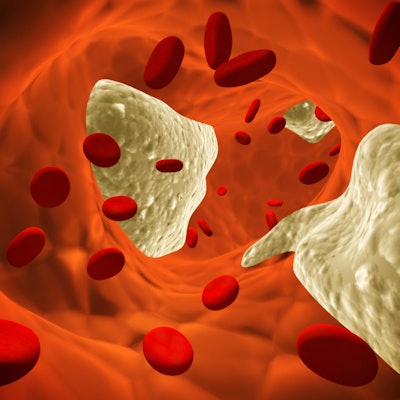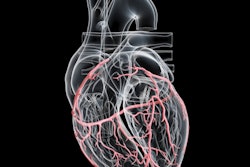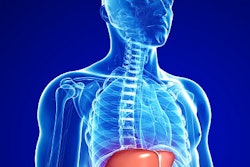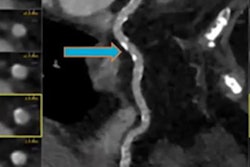
An artificial intelligence (AI) algorithm can accurately quantify plaque on coronary CT angiography (CCTA) exams, according to research presented July 16 at the annual meeting of the Society of Cardiovascular Computed Tomography (SCCT).
A multinational team of researchers led by Damini Dey, PhD, from Cedars-Sinai Medical Center in Los Angeles reported that their deep-learning algorithm for CCTA-based plaque quantification yielded rapid measurements of plaque volume and stenosis severity that correlated closely with expert readers and intravascular ultrasound (IVUS).
What's more, the algorithm yielded high diagnostic performance for grading stenosis.
"[The model] thus has the potential for integration into routine CCTA workflow to aid clinicians," said presenter Dr. Andrew Lin, PhD.
CCTA is a first-line test for evaluating stenosis severity, and whole-heart quantification of atherosclerosis on CCTA enables accurate assessment of coronary artery disease burden and prognosis, according to Lin. However, current semiautomated plaque analysis methods are time-consuming and require high levels of expertise, he said.
As a result, the researchers sought to develop and externally validate a deep learning-based approach for CCTA-based measures of plaque volume and stenosis severity. The international multicenter study encompassed 11 sites, and the training set included 921 patients with 5,045 lesions.
The researchers trained their hierarchical convolutional long short-term memory (LSTM) network to provide automated segmentation of the vessel wall, lumen, and plaque components. Measurements by expert readers served as the ground truth for the training data.
Testing was conducted on an unseen test set that included an external validation cohort of 175 patients and a cohort of 100 patients with 820 lesions that had paired CCTA and invasive coronary angiography/IVUS exams within 30 days. The researchers evaluated the performance of the algorithm for measuring plaque volume and stenosis severity in the test set against the expert readers and IVUS.
Lin et al also assessed the diagnostic accuracy of the algorithm for grading stenosis according to Coronary Artery Disease Reporting and Data System (CAD-RADS) categories in comparison with expert interpretation of CCTA and invasive coronary angiography.
The algorithm produced excellent agreement and correlation with expert readers, yielding intraclass correlation coefficients (ICC) of 0.964 for total plaque volume, 0.949 for noncalcified plaque, 0.945 for calcified plaque, and 0.777 for low-density noncalcified plaque. It also achieved an ICC of 0.839 for diameter stenosis percentage.
In a subset of 50 patients who also received IVUS exams, the researchers also found close agreement and correlation (ICC = 0.949 and Spearman's correlation coefficient r = 0.905) between the algorithm's and IVUS measurements for total plaque volume.
Strong agreement for CAD-RADS categories was also found for AI with expert CCTA interpretation (kappa = 0.81), and with visual stenosis grading by interventional cardiologists on invasive coronary angiography (kappa = 0.75).
| Performance of LTSM algorithm for identifying significant stenosis on CCTA | ||
| AI vs. expert CCTA interpretation | AI vs. visual stenosis grading on invasive coronary angiography | |
| Accuracy for > 50% stenosis per vessel | 94.4% | 92.6% |
| Accuracy for > 50% stenosis per patient | 92.6% | 87.5% |
| Accuracy for > 70% stenosis per vessel | 98.8% | 96.7% |
| Accuracy for > 70% stenosis per patient | 98.1% | 93.8% |
The AI model exhibited high diagnostic performance for detecting significant stenosis at both the 50% and 70% thresholds at both the per-vessel and per-patient levels, with high sensitivity, specificity, positive and negative predictive values, and diagnostic accuracy, according to Lin.
In addition, the algorithm generated its results in an average of 5.7 seconds per patient, compared with an average of 25 to 30 minutes for the experts, according to Lin.





















